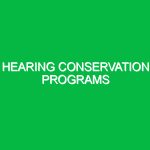Introduction
Noise exposure is an often overlooked yet critical component of workplace health, safety, and environment (HSE) management. The process of assessing and managing noise exposure involves identifying sources of noise, evaluating potential risks to workers, and implementing strategies to mitigate these risks. In industries ranging from construction to manufacturing, excessive noise can lead to hearing loss, increased stress levels, and decreased productivity. Understanding how to effectively assess and manage noise exposure is essential for safeguarding employee well-being and maintaining compliance with relevant regulations.
The Importance of Assessing and Managing Noise Exposure
The relevance of assessing and managing noise exposure in the HSE domain cannot be overstated. According to the World Health Organization, over 1 billion young people are at risk of hearing loss due to unsafe listening practices and noise exposure. In occupational settings, prolonged exposure to high noise levels can result in irreversible hearing damage, which not only affects the individual but can also lead to significant financial consequences for businesses. The cost associated with hearing loss, including medical expenses, compensation claims, and lost productivity, underscores the necessity for robust noise management strategies.
Identifying Potential Hazards and Risks
When assessing noise exposure, it is crucial to identify potential hazards and risks associated with high noise levels. Noise can originate from various sources, including machinery, tools, transportation, and even environmental factors like traffic. Here are some common hazards:
1. Machinery and Equipment
In manufacturing and construction settings, machinery such as compressors, generators, and power tools can produce significant noise levels. For instance, a construction site can expose workers to noise levels exceeding 85 decibels (dB), which is the threshold for mandatory hearing conservation programs as per OSHA regulations.
2. Environmental Noise
In urban areas, environmental noise from traffic, construction, and industrial activities can contribute to overall exposure. Workers in these environments may not only face occupational noise but also ambient noise, which can compound exposure risks.
3. Personal Habits
Interestingly, personal habits, such as listening to loud music through headphones, can also increase the risk of hearing loss. This factor is particularly relevant for younger workers who may lack awareness of safe listening practices.
4. Work Processes
Some work processes, like demolition or heavy lifting, can elevate noise levels. Understanding these processes can help organizations implement targeted measures to reduce exposure.
Detailed Safety Precautions and Best Practices
To effectively manage noise exposure, employers should adopt a combination of engineering controls, administrative controls, and personal protective equipment (PPE). Here are some best practices:
1. Engineering Controls
Implementing engineering controls is one of the most effective ways to manage noise exposure. This includes:
- Sound Barriers: Installing barriers or enclosures around noise sources can significantly reduce the amount of noise that escapes into the surrounding environment.
- Maintenance: Regular maintenance of machinery can minimize noise levels. Worn-out or poorly lubricated equipment tends to be noisier.
- Equipment Selection: Choosing quieter machinery or tools can have a profound impact on noise levels in the workplace.
2. Administrative Controls
Administrative controls involve changing the way work is organized. This can include:
- Work Scheduling: Rotating employees to limit their exposure to noisy areas can help reduce overall risk. For example, staggering shifts in a loud manufacturing plant can minimize the number of workers exposed at any given time.
- Training and Awareness: Providing training on the dangers of noise exposure and proper use of PPE can empower employees to take responsibility for their hearing health.
3. Personal Protective Equipment (PPE)
PPE should be considered a last line of defense in noise management. Effective options include:
- Earmuffs: These can provide a high level of noise reduction and are ideal for environments with continuous noise.
- Earplugs: These are useful for intermittent noise exposure and are often more comfortable for longer wear.
PPE should be used in conjunction with other controls and not as a standalone solution.
Regulations and Standards Governing Noise Exposure
Several regulations govern noise exposure in the workplace. Understanding these is essential for compliance and effective noise management. Key regulations include:
1. Occupational Safety and Health Administration (OSHA)
OSHA establishes permissible noise exposure limits. According to OSHA, the permissible exposure limit (PEL) for noise is 90 dB for an 8-hour workday. However, for every 5 dB increase in noise, the exposure time must be halved. OSHA also requires employers to implement a hearing conservation program when noise levels exceed 85 dB.
2. National Institute for Occupational Safety and Health (NIOSH)
NIOSH recommends lower exposure limits than OSHA, suggesting a recommended exposure limit (REL) of 85 dB for an 8-hour day. They also emphasize the importance of hearing conservation programs, education, and periodic hearing tests.
3. Environmental Protection Agency (EPA)
The EPA focuses on community noise and establishes guidelines for acceptable noise levels in residential areas. While their regulations are not specific to occupational settings, they highlight the importance of overall noise management and community health.
Real-Life Examples of Effective Noise Management
To illustrate the importance of assessing and managing noise exposure, consider the case of a manufacturing plant in Ohio. After conducting a thorough noise assessment, the facility identified key areas where noise levels exceeded safe limits. They implemented a series of engineering controls, including sound enclosures around high-noise machinery and the installation of quieter equipment. As a result, reported cases of hearing loss among employees decreased significantly within a year. Additionally, the company saw an increase in productivity, as workers were less distracted by noise and could communicate more effectively.
Conclusion
Assessing and managing noise exposure is an integral part of maintaining a safe and healthy work environment. By understanding the sources of noise, identifying potential risks, and implementing effective control measures, organizations can protect their employees’ hearing and overall well-being. Moreover, compliance with regulations such as those established by OSHA and NIOSH is not only a legal obligation but also a moral imperative. Investing in noise management is a step towards a healthier workforce and a more productive workplace.


